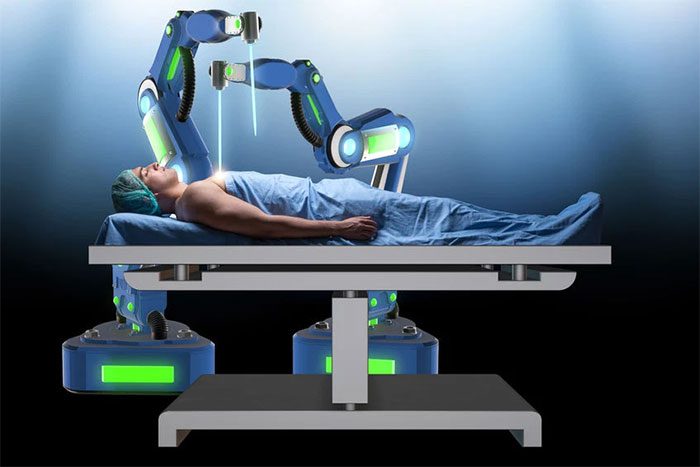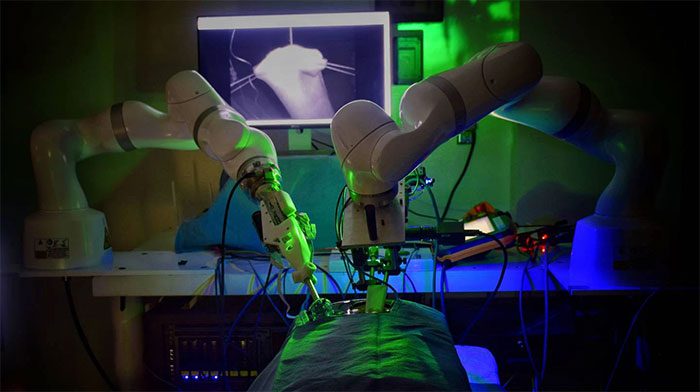As we all know, the race into outer space is not just to satisfy human curiosity. It also fosters the development of numerous technologies that have become integral to our daily lives right here on Earth.
If you didn’t know, wireless headphones, laptops, LED lights, computer mice, smartphone cameras, as well as technologies for sports shoe soles, water purifiers, air filters, solar panels, braces, LASIK eye surgery, insulin pumps, and prosthetic limbs… were all invented during the quest to conquer space.
Now, scientists predict that a very advanced technology is on the horizon: automated surgical robots.

Current surgical robots are only semi-automated.
At present, we have robots capable of performing many medical procedures, including pelvic surgery, spinal surgery, eye surgery, and lumbar punctures… all of which require extremely high precision.
However, the current surgical robots are only semi-automated. This means they are designed like machines, operated by technicians and surgeons.
Surgeons who wish to control these machines must also undergo a certification course, similar to obtaining a driver’s license. Fully autonomous medical robots, like self-driving cars, are still a concept from science fiction.
A Catalyst is Needed for the Field
Closest to a fully automated surgical robot, earlier this year, Johns Hopkins University successfully performed its first complex soft tissue surgery with a machine called STAR.
STAR is an intelligently programmed robot that successfully stitched two segments of intestine together. This is one of the most sophisticated procedures in abdominal surgery.
However, why don’t we count STAR among the robots mentioned above? Because, although STAR operates entirely autonomously, the patient it treated was just a pig.
Nevertheless, Johns Hopkins considers this a remarkable achievement, “a significant step towards fully automated surgery on humans.” They posed the question: When will we advance to that futuristic future?

The STAR surgical robot system from Johns Hopkins.
“I think it will take several decades, at least a few more decades,” said Dr. Tamir Wolf, CEO of Theator, a company developing automated surgical platforms with artificial intelligence.
“I believe that once again, it depends on the space race. Because that is the domain where automated surgical technology can bring value.”
A Robot that Could Replace a Medium-Sized General Hospital
Dr. Wolf stated that unlike missions in low Earth orbit, on the International Space Station (ISS), or even on the Moon, future missions to Mars and deep space will last a very long time.
Assuming the most optimal orbit, as depicted in The Martian, humanity’s most powerful spacecraft would take 260 days to reach the red planet. Adding the time spent on the mission there and the time for the return trip, the mission could last for years.
Such prolonged space travel poses numerous medical risks for the crew. While we could bring along a doctor, a single doctor is simply not enough.
The Martian: Matt Damon has to perform surgery on himself while on Mars.
If you need specialized surgery for the intestines, brain surgery, or heart surgery, you truly need different doctors. Essentially, you would have to shrink a medium-sized general hospital and fit it into a spacecraft if you want to ensure the survival of astronauts.
Alternatively, you could develop an automated surgical robot and load various programs into it. This second development direction is clearly more promising. A robot takes up little space, does not consume oxygen or drinking water, and if well programmed, will operate with absolute precision.
Remember that Elon Musk’s Neuralink is also developing a robotic arm for brain surgery, capable of stitching thin electrodes that are only 1/20 the width of a human hair into the cortex. To achieve this accurately, the robotic arm is programmed to eliminate vibrations caused by the patient’s breathing and heartbeat.
Self-Driving Cars, Next Up: Self-Surgery Robots
Elon Musk’s technology ecosystem clearly supports each other in a very harmonious way. He is developing surgical robots and has ambitions to send humans to Mars. Additionally, there are self-driving cars.
“If you look at the development of surgical robots and compare it to what is happening in the automotive industry, you will see similarities between them,” Dr. Wolf said.
We currently have to drive cars ourselves, just as doctors must manually control robotic arms. But both fields are moving towards partial automation, meaning there are software components that assist in partially automated driving.

Elon Musk is developing surgical robots and has ambitions to send humans to Mars.
“And then, there will be conditional full automation, when the car starts to understand its environment. Following that will be high levels of automation, where the car participates in the decision-making process, and ultimately, full automation,” Dr. Wolf explained.
For surgical robots, he believes we are already moving towards partial automation. Surgical robots like STAR from Johns Hopkins University are an example.
“This is evidence of the initial concept showing that surgical robots are capable of automating their tasks,” Dr. Wolf said. “I believe we are heading in the right direction, and this is certainly a significant leap forward.”





















































